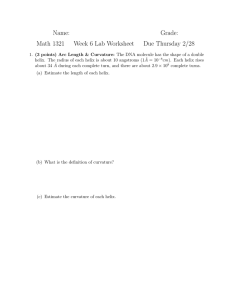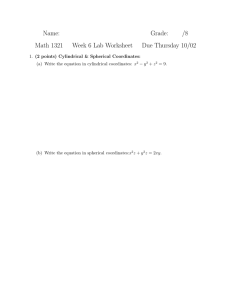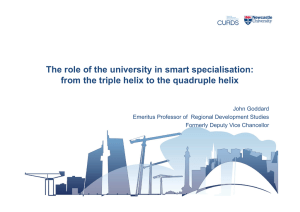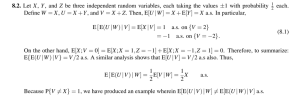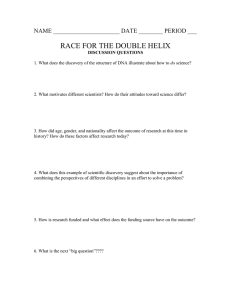BY OZWWDVA
advertisement
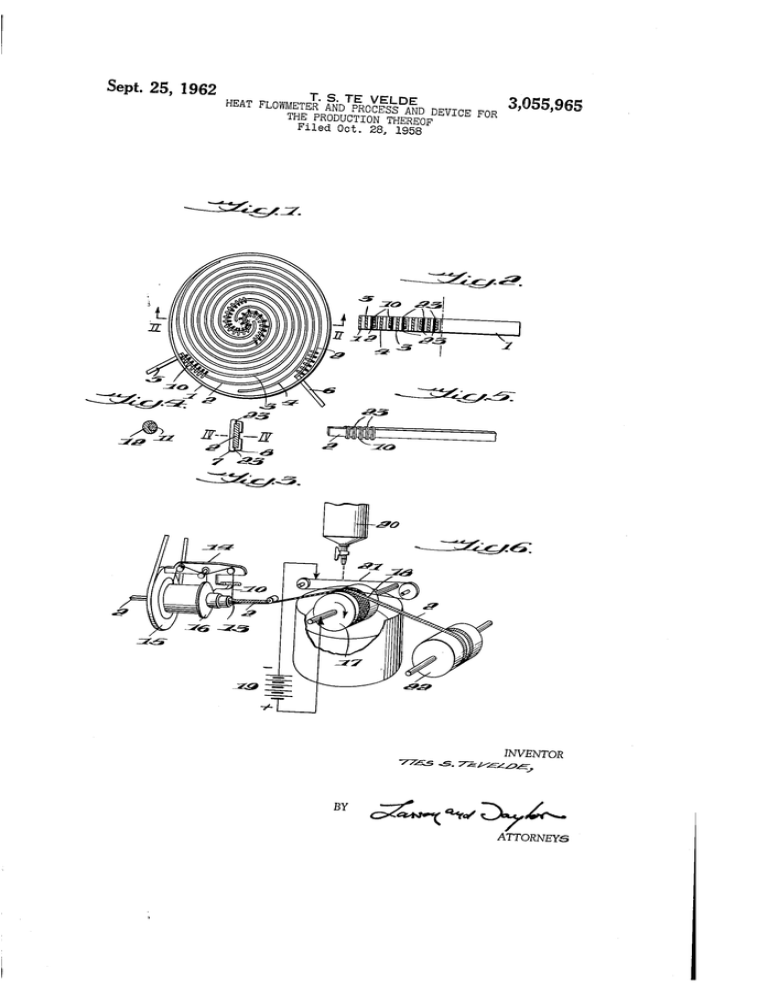
Sept. 25, 1962 T. AND s. TE VELDE HEAT FLOWMETER PROCESS AND DEVICE FOR 3,055,965 THE PRODUCTION THEREOF Filed Oct. 28, 1958 INVENTOR was 5. 7751/5406 BY OZWWDVA ATTORNEYS United States Patent O??ce 1 2 place of contact with the cylinder with substantially the 3,055,965 HEAT FLOWMETER AND PROCESS AND DEVICE FOR THE PRQDUCTR'ON THEREUF Ties S. te Velde, Delft, Netherlands, assignor to The Nederliantlse Centrale @rganisatie voor Toegepast same speed as the rotation velocity of the surface of the cylinder, so that on this place of contact the turns of the helix do not move with respect to the impregnated sur face layer. Natnurvs'etenschappeiijlr Underzoeh, The Hague, N?‘llh Preferably said core with said helix is pressed on and erlands, a corporation of the Netherlands Filed Oct. 28, 1958, §er. No. 770,203 Claims priority, application Netherlands Oct. 30, 1957 7 Claims. (Cl. 136-89) 3,055,965 Patented Sept. 25, 1952 against said impregnated surface layer with a co-moving conductive endless string to which the negative pole of a 10 direct current source may be connected. The positive pole of said current source may be con The invention relates to a heat ?owmeter containing a great number of thermoelements connected in series, nected to said metal cylinder. It has been found to be possible to coat with this proc~ which have been wound on a bearer of insulating ma ess a constantan wire with a diameter of 0.02 mm. and terial, by winding a metal wire round a band of insulating wound with a pitch of 0.13 mm. on an insulating band, material and coating half of each turn of said metal wire 15 for example consisting of Te?on, 2 mm. wide and 0.125 with a thermoelectrically dissimilar metal, and to a proc mm. thick, for one half with copper ‘without it being ess and device for the production thereof. necessary to provide the other half with a layer of wax Heat ?owmeters, containing a large number of thermo or lacquer with the di?iculties connected therewith, whilst the “junctions” were lying on the edges of the band. elements connected in series, wound on a bearer of in sulating material and, if desired, placed in a plate or 20 The tape-shaped heat ?owmeter according to the sheet of an insulating synthetic resin, are known. process of the invention can erg. be rolled up and taken In these known heat ?owmeters the elements generally up between one or more bands of an insulating material, to form a sheet containing approximately 1500 elements consist of a helix of constantan wire, one half of each per cm.2. winding of said helix having been copper coated electro lytically or chemically. For the purpose of reinforcement and ?nish this plate can be pressed into a ring of a synthetic resin, for ex In the known process for producing these elements one ample of Te?on. half of each winding is protected with a layer of wax or lacquer, the other half being subsequently electroplated, It is possible still further to reduce the dimensions of after which the layer of wax is removed. _ the constantan wire, the pitch of the windings and also the dimensions of the band to a considerable extent with The layer of Wax should be provided very carefully on out the occurrence of difficulties in this process. these windings in such a way, that the junctions of the‘ In this way heat ?owmeters with 3000 and more ele couples co-operate, which is a tedious and elaborate proc ments per cm.2 were made. Thus, in a round disc with a ess especially for a large number of very small thermo couples. In the co-pending application Serial No. 707,534 of January 7, 1958 a heat ?owmeter is described contain ing a large number of thermoelements wound into a helix wherein each turn of the helix has e.g. a rectangular shape. Approx. 600 elements could be placed in the heat ?ow meter per cm? of surface; the sensitivity is then approx. 1 mv. for a heat ?owmeter with copper constant and ele diameter of 1 cm., more than 22.50 thermoelements can be placed, as a result of which the sensitivity of such a ?owmeter containing copper constantan elements is 1 mv. at a heat?ow density of 10 kcal./hour/m.2. The helix may be of any material which is thermoelec trically dissimilar to the material of the coating. For the electrolytical coating of the said helix metals such as e.g. platinum, gold, silver, iridium, palladium, rhenium, rho dium, chromium, iron, nickel, cobalt, copper, cadmium, a plate of l cm.2. zinc and tin can be used. The following combinations of metals can be used to It is the main object of the present invention to pro vide for a method for producing heat ?owmeters of even on a gold-palladium alloy, iridium on an iridium-rhodium greater sensitivity by a simple process. Other objects and advantages will be apparent from the following detailed copper-nickel, copper-constantan, silver-constantan, iron The process of the invention comprises winding a constantan, wherein the last-mentioned metal of the com bination always represents the metal of the helix. In the accompanying drawings: ments at a heat?ow density of 50 kcaL/hour m? through description. metal wire as a helix on a pliable ?at core of insulating material, thereafter electroplating of all the turns of said helix the parts lying on one side of said ?at core, so that about one half of each turn is plated and the joints of advantage: platinum on a platinum-rhodium alloy, gold alloy, nickel on a nickel-chromium alloy, nickel-copper, FIGURE 1 shows a view of an embodiment of a heat ?owmeter according to the invention. FIGURE 2 is a cross-section through this meter taken . plated and unplated sections are situated substantially on 55 on the line II—-II of FIGURE 1. the edges of the flat core, by pressing one ?at side of FIGURE 3 presents, on an enlarged scale, a section said core with said helix on and against a body having through the band of synthetic resin with on it a single turn a porous surface, said porous surface being impregnated of the helix in front view, which helix forms the thermo elements connected in series. with a solution of a salt of a metal thermoelectrically dis similar to that of the helix and electrodepositing by direct 60 FIGURE 4 is a section through this turn taken on the current through the said helix and said solution on the line IV—IV in FIGURE 3 on an even more enlarged scale. parts of all the turns of said helix situated on that flat side of the core contacting the solution in said porous FIGURE 5 shows a heat ?owmeter according to the invention comprising the band of synthetic resin with the surface a layer of said thermoelectrically dissimilar metal. 65 Preferably the solution impregnated surface layer is helix forming a number of thermoelements connected in series, also on an enlarged scale. mounted on a metal cylinder, rotatable around a hori— FIGURE 6 is a diagram of the ‘apparatus with which zontal shaft, so that on rotating the cylinder the surface these heat ?owmeters are made. layer is alternately soaked with the solution present in a In FIGURE 1 and FIGURE 2 reference numeral 1 container under the rotating cylinder and contacted with indicates a ring of synthetic resin with a bi?lar band of the helix, pressed against the top of the rotating cylin synthetic resin 2 which has been rolled up and which der. Preferably the core with the helix moves at the has been pressed into the ring of synthetic resin, on 3,055,965 3 which band there is a constantan wire 10 which is cop pered over half of its turns and is placed between two bands of synthetic resin 3 and 4. In the ?gures the junc tions between the coated and uncoated parts are indicated by reference numeral 23. It is possible to provivde a lacquer or another insulat ing layer to the helix, by which the bands of synthetic resin 3 and 4 can be left out. The terminals 5 and 6 can be mounted directly on the a 2. A heat ?owmeter according to claim 1, wherein said insulating material is a lacquer coating on the turns of the helix. 3. A heat ?owmeter according to claim 1, wherein said insulating material is at least one band of an insulating synthetic resin between the turns of the spirally coiled up helix. 4. A heat ?owmeter according to claim 1, wherein said sheet is fastened in a ring of synthetic resin. 5. A heat flowmeter according to claim 1, in which 10 said sheet and said ring are covered by a ?lm of a syn helix. In FIGURE 3 it is indicated that the part 7 of each thetic resin. turn is coppered; the copper surface is indicated in FIG 6. A heat flowmeter comprising a helix of a metal URE 4 by reference numeral 12, the constantan surface wire wound on a band-shaped bearer of an insulating by 11. synthetic resin, wherein about one half of each turn of FIGURE 6 shows how the helixes are mounted on the 15 said helix is coated with a surface layer of a metal band of synthetic resin and how they are subsequently coppered. Te?on can be taken for the insulating bands of the heat ?ow-meter; band of another insulating substance as e.g. a synthetic resin or a silicon can, however, also be used for the same purpose. thermoelectrically dissimilar to that of the helix and all the junctions of the coated and the uncoated parts of the turns lie substantially on the edges of said bearer and wherein said metal helix with said bearer is coiled into a bi?lar spiral forming a sheet containing at least 1500 turns of said helix per cm.2 and wherein said junctions The apparatus for the production of the helixes shown lie on both sides on the surfaces of the sheet and wherein in FIGURE 6 comprises a head 13. The constantan wire said turns of the helix are prevented from contacting 10 is Wound from the supply-coil 16 onto the band of each other by an insulating material. 1 synthetic resin 2 by means of the rotating arm 14, 25 7. A heat ?owrneter comprising a helix of constantan mounted on the driven disc 15. Wire wound on a band-shaped bearer of an insulating Subsequently one half of each turn is coppered gab vanically; to that end the band of synthetic resin 2 with synthetic resin, wherein about one half of each turn of said helix is coated with a surface layer of copper and all the junctions of the coated and the uncoated parts of 30 gauze being impregnated with a metal salt solution drip the turns lie substantially on the edges of said band ping from a container 20. The gauze is mounted on shaped bearer and wherein said helix with said bearer is a rotatable cylinder 17, which is connected with the posi coiled up spirally, forming a sheet containing at least tive pole of the voltage source 19. 1500 turns of said helix per crn.2 and wherein said junc The endless wire 21 is connected with the negative tions lie on both sides on the surfaces of the sheet and pole of the vovltage source 19 and presses the band 2 wherein said turns of the helix are prevented from con with the wire ‘10 on the gauze 18. tacting each other by at least one band of an insulating The band with thermoelements thus obtained is wound synthetic resin between the turns of the spirally coiled-up the wire 10, is led over a gauze of textile cloth 18, said helix and wherein said sheet of spirally coiled-up helix on a driven reel 22. It is also possible to provide the band with a helix of with said bearer is fastened in a ring of a synthetic resin another metal or another alloy and to provide this helix 40 and wherein said sheet ‘and said ring are covered by a with still another metal so that each turn of said helix ?lm of a synthetic resin. forms a suitable thermoelement. References Cited in the ?le of this patent If the bearer is not desired for one reason or another it can be dissolved. The heat ?owmeter then consists of UNITED STATES PATENTS a helix of thermoelements which can or cannot be mounted between 2 sheets. I claim: 1. A heat ?owmeter comprising a helix of a metal wire Wound on a band-shaped bearer of an insulating synthetic resin, wherein about one half of. each turn of said helix is coated with a surface layer of a metal ther moelectrically dissimilar to that of the helix and all the junctions of coated and uncoated parts of the turns lie substantially on the edges of said bearer and wherein said metal helix with said bearer is coiled up spirally forming 55 a sheet containing at least 1500 turns of said helix per crn.2 and wherein said junctions lie on both sides on the surfaces of the sheet and wherein said turns of the helix are prevented from contacting each other by an insulating material. 60 1,643,734 1,706,419 2,310,026 2,519,785 2,562,696 2,629,757 2,674,641 2,698,832 2,798,849 2,807,657 2,849,350 Zworyhin ____________ __ Sept. 27, Thorpe ______________ __ Mar. 26, Higley _______________ __ Feb. 2, Okolicsanyi ________ __ Aug. 22, Canada _____________ .._ July 31, McKay _____________ __ Feb. 24, Holmes ______________ __ Apr. 6, Swanson _____________ __ Ian. 4, Lindsay _____________ __ July 9, Jenkins et a1. ________ _.. Sept. 24, Roach _____________ __ Aug. 26, 1927 1929 1943 1950 1951 1953 1954 1955 1957 1957 1958 2,893,929 Schnable _____________ __ July 7, 1959 44,294 France _____________ __ Dec. 13, 1934 FOREIGN PATENTS


